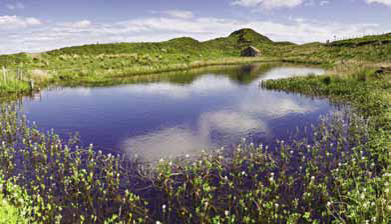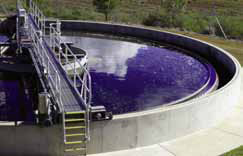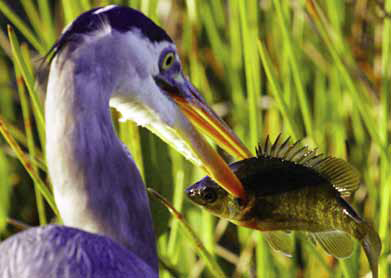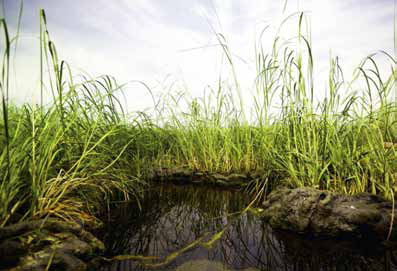The Arcata Marsh at Work
Water treatment in the constructed marsh begins when sewage flows into the collection area. Here, wastewater is separated from sludge. The sludge is treated and ultimately becomes compost to be used on the town's flowerbeds and forest floors.

The wastewater travels to an oxidation pond, where sunlight kills most of the microbes. It then flows into a series of marsh ponds and mixes with water from the bay.
Hairs that grow along the roots of marsh plants attract any remaining pollutants, and bacteria living near the roots break them down into harmless chemicals. Finally, the clean water makes its way into Humboldt Bay.
 In an oxidation pond, brackish water from the bay meets treated wastewater.
In an oxidation pond, brackish water from the bay meets treated wastewater.
 As sludge settles out of the wastewater, the rotating arm atop the clarifying tank removes grease and soils.
As sludge settles out of the wastewater, the rotating arm atop the clarifying tank removes grease and soils.
Now, herons, snowy egrets, and pelicans live and feed along the marsh. Swallows take to the air, dining on mosquitoes. Nests are safely tucked away in bulrushes that grow in the shallow wetland. But plants and animals aren't the only ones who enjoy Arcata's constructed marsh. Since it opened, it has become a popular hiking, picnic, and fishing area for residents of the town. Locals, who fought to build the marsh, now enjoy its beauty year-round.
 A heron spears its prey with a quick lunge of its bill. Herons eat a great variety of animals, including fish, amphibians, birds, and reptiles.
A heron spears its prey with a quick lunge of its bill. Herons eat a great variety of animals, including fish, amphibians, birds, and reptiles.

DID YOU KNOW?
Bill Giese, a wildlife manager, and Dr. Brian Needelman, a soil scientist at the University of Maryland, are part of a team intent on restoring marshes at the Blackwater National Wildlife Refuge in Maryland. One of their goals is to reduce carbon dioxide emissions that contribute to global warming. The team rebuilds wetlands by planting marsh grasses in soil pumped in from the bottom of rivers and bays. When marsh grasses die and decompose in the water, they take carbon dioxide out of the atmosphere. An acre of healthy marshland can remove 3 to 8 tons of carbon dioxide each year.